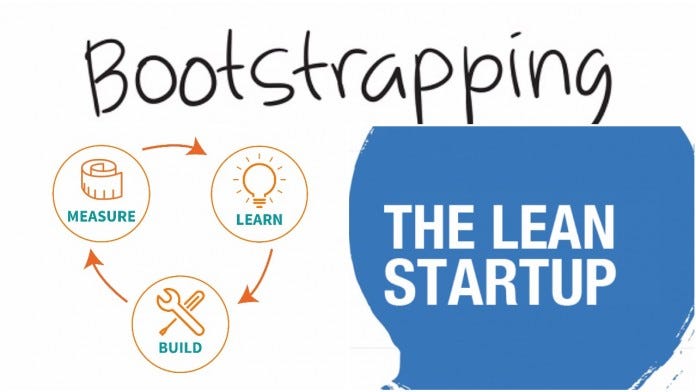Bootstrapping a start-up, without quitting your job immediately
On a regular day when you are busting your butt off at work, or over the weekend when you are drowning yourself in your favourite poison after a long and difficult week at work — and then it suddenly hits you. You have an idea which can solve a problem and grow into a sustainable business, or get you a profitable exit. Your AHA moment!!
HOW DO YOU BOOTSTRAP A NEW BUSINESS WITHOUT TAKING A MASSIVE FINANCIAL HIT?
You’ve been bitten by the entrepreneurial bug and your days as a salaried employee could be limited.
The next obvious thing for you is to figure out how to start building your business, without quitting your job. Based on my personal experience of bootstrapping a startup 12 months ago, here’s what you should follow:
Start with figuring out how much money you are going to need for all your necessary personal expenses (essentials, rent / EMI, travel, etc) for 12 months (or 18 months or 6 months, depending on how long you want to try out and risk before taking a call, in case things don’t work out the way you want them to), and plan how quickly you can save that money in order to enable you to take the plunge.
A simple hack that nobody tells you about is to cut down on some unnecessary expenses.
You may figure out that you will need to work for another 12 months to save enough for the 12 months after that. What a downer!!!! “What the hell am I supposed to do for 12 months when I know that the idea that I have is going to become a successful business. Venture Capitalists are going to line up outside my office, begging me to take their money, and every one of my target customer is going to buy the product or service that I will offer? What if somebody else executes this idea before I start working on it and gets ahead?”
The good news is that you need not put the idea on the back burner. You can start working on your idea from THIS VERY MOMENT. You could be working 12–13 hours a day on your job (and the loooong commute to work) everyday, 5 days a week. You need your 8 hours sleep every day to lead a healthy lifestyle. Exercise, daily chores, etc, are going to eat up the remaining 3–4 hours every day. And you need to give at least one day every week to your family. Then how the hell do you work on your idea without quitting your job?
WEEKEND ENTREPRENEURSHIP: NOW WHAT THE HELL IS THAT?
Utilise your free time over the weekends and during holidays to put your ideas on paper. Calculate how much money you will need to bootstrap to execute the idea and sustain the operations for 12 months, and to look at ways in which you can raise funds — personal savings (add another few months to the 12 months you need, at the very least) and funding from family and friends are the only realistic options available for you at this very moment.
Private Equity investors (including angel investors and venture capital funds) will not likely come on board unless you have an MVP (Minimum Viable Product), a sound business plan backed by a thorough market research, and proof of a customer base waiting to get their hands on your product.
While running your initial assessments, identify the exact problem that you are trying to solve, find out the solutions which are already available, and answer the following questions:
1. How is your solution different or better than what is already available?
2. What resources will you require to build the product which solves the problem?
3. What are the barriers to the entry?
4. Who is going to buy your product?
5. How can you ensure that your product will withstand the competition?
6. What is your objective behind the start up? Are you looking to build a company which can be sustained for a long time, or a company that you can exit with a profit? How will you build it?
You may not have the all the resources and skills that the business needs. A different perspective will not be a bad thing. Consider getting a co-founder on board. One or may be two, but not more than that. The person/s must share your vision (but is/are ready to point out a flaw in it, if required), has / have similar inclinations and an objective way of thinking, and money, time and skills to invest into the venture.
With the founding team sorted, you need to carry out a detailed market research to understand the real problem and the viability, feasibility, and scalability of your solution.
THE UNEXPECTED STRUGGLES
You may be 3 months in, since that AHA moment and you mayhave been working 13 hours a day, 7 days a week. The pressure at work is more than ever before, your family needs more attention, and you incur unexpected expenses which push your plans further by another couple of months.
Prioritise! You can afford to go 8 weeks without working on the idea, if the situation demands it.
Things will ease out a bit after some time and you will be able to work on your idea on the weekends again. Set out a time line for your team. In the next 4–5 months, get a prototype ready while also being half-way through the business plan, and working on building a pipeline of the customers who may be interested in buying your product. Test the prototype for possible errors and spend some more time to identify the improvements which can be made.
For the next few months after this, set a target to get the MVP ready. Start running the tests and go through your checklist. Evaluate, once again, how much money you need to personally survive for the next 12 months and to invest further in this start-up.
If you are sure that you have got enough, put in your papers and wait for the day when you walk out of your office one last time, with a big smile and dreams of conquering the world. It’s really happening, you have made it!
In spite of all the screw-ups in life and the arguments with your cofounders, you have reached the stage where you are ready to take the leap!!!! Your product launch is just a few weeks away.
Hustle for the next few weeks, test your MVP to make the necessary changes to your product, test again and run a campaign for the launch of your product. You may have to work 100 hours a week to make sure that the launch goes as per the plan and the customers really like what you are offering.
Offer this MVP to a limited group of customers and gather feedback. If the customers love it and you have more than 90% positive reviews, with 70% people ready to sign up to use your final product, you have received market validation and built your sales pipeline.
RAISING FUNDS: DO YOU REALLY NEED TO TAKE THE VC / ANGEL ROUTE?
How much funds do you need to capture the market? Do you really need to raise funds from an outside source? Personally, I am a huge fan of bootstrapping, if you have the resources to do it. This way, the founders have their skin in the game and you are guaranteed complete control of the business.
You can scale at your own pace, without worrying about a board looking to increase the topline to drive up the valuation and raise round after round of funding, while diluting your stake to a point where it becomes insignificant and you are nothing more than a top level executive working on the vision of a board full of investors looking to make a profitable exit (well, it’s not as bad as it sounds, in majority of the cases and in certain industries, businesses cannot survive without aggressive and exponential growth in topline).
The Indian government has been focused on promoting entrepreneurship in India. Indian start-ups can find out and avail the benefits of the central government promoted, applicable and industry specific schemes and subsidies. At any stage of the business, start-ups can also look at the debt funding options available.
Indian Banks and NBFCs have seen the potential in start-ups and are willing to provide credit facilities, if you have a good product, team, market, and a business plan with justifiable financial projections.
The biggest myth is that you need to burn X for Y months, to reach sales of X per month in the (Y+1)th month.
The key to building a successful bootstrapped business lies in giving equal importance to the topline and the bottom line. Strive to break-even and minimize the expenses to achieve profitability at the earliest.
Post your launch, the major chunk of your cash will burn on salaries, rent, and marketing. While the only options to save money on rent are by working from home / a co-working space or by sharing an office with another start-up, there are ways in which you can minimize your outgo on salaries and marketing.
MINIMISING YOUR COSTS: ESOP AND AUTOMATION
Develop ways to automate the redundant processes of your business, which will save you some money on hiring for those redundant jobs. Offer ESOP with a 12 month vesting period to your core team and offer a target based salary structure to your sales team.
What about marketing? For an internet based start-up, digital marketing is absolutely critical. Do you really need to hire an agency to manage your digital marketing at an early stage? Not really!! There are cheaper and better options available in the market, like Dfizz.com — a digital marketing automation software, which builds a website in real time (along with domain and hosting) and with the help of artificial intelligence, automates social media marketing, including content discovery and search engine optimized content creation relevant for your business. In addition to the above, Dfizz.com provides CRM, Graphic Designing, and customer engagement on social media. All of this provided at a fraction of the cost that you will incur on hiring a social media manager / agency.
WHAT HAPPENS IF THINGS DO NOT GO AS PLANNED?
Your idea is as good as your execution is. If things do not go as you had planned and the traction is lower than estimated, you need to pivot, if you are convinced that the product is a good fit for the market. Maybe you are not able to offer your product to the market convincingly. Maybe your sales team is not able to convey the right message to your customers.
You need to roll your sleeves up, work on new strategies and make changes to your products based on the feedback from the customers. In the worst possible case, if you assess that your initial market research was incorrect and your product is not a good fit for the market, or if situations beyond your control (economic, political, social) have created an environment where you cannot survive, it is time to learn your lessons, minimize your losses, and move on.
In the best case scenario, you will either build a company which can be acquired for a lot of money or then you build a business which will gradually transform from a start-up to an SME, to a large unlisted private company and finally, to a Large Listed Company.
To conclude it is possible to bootstrap a start-up, without quitting your job in the initial phase, as long as you are clear about your objectives, your target market, your sales and marketing strategy and are able to build a product which differentiates itself from the others.
Thank you for reading. If this was helpful to you, don’t forget to clap and share. Have a different opinion? Lets connect on support@msmemitra.com
ABOUT ME: I bootstrapped MSMEmitra.com with Ashish Jacob in India, to provide financial consultancy and business advisory services to start-ups and SMEs, help businesses find out the most suitable funding options and the applicable schemes and subsidies, and provide assistance in raising funds through our network of Banks, NBFCs, VCs, and PE Investors. At present, we are also working on developing a platform to profile, promote and rank (based on certain key metrics) start-ups and high growth potential SMEs for potential investment opportunities.






Comments
Post a Comment